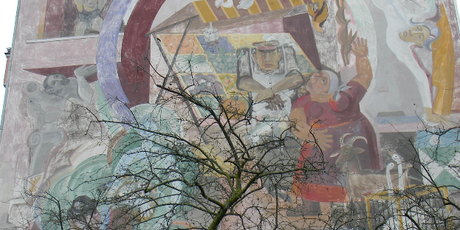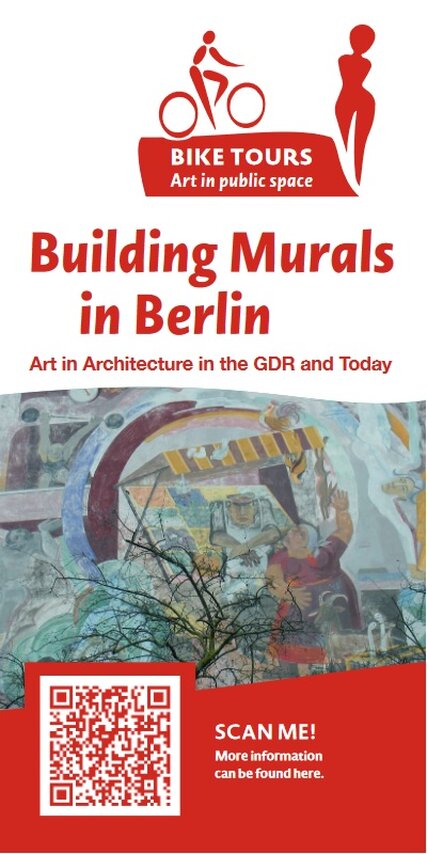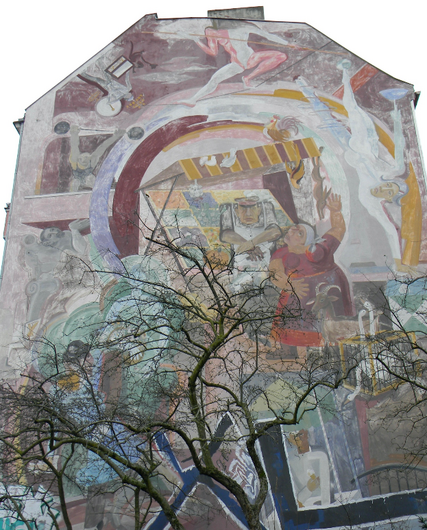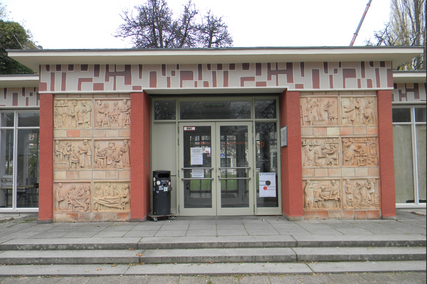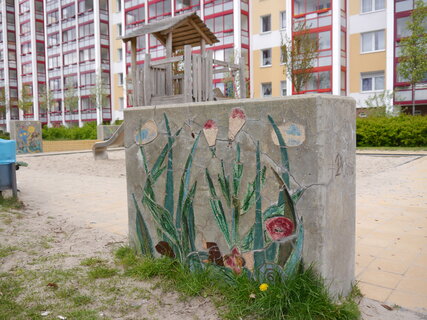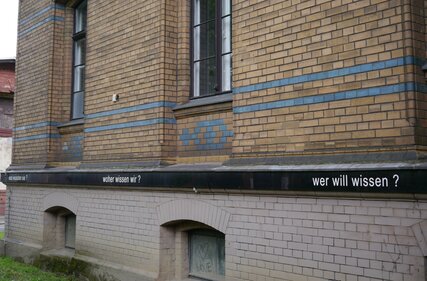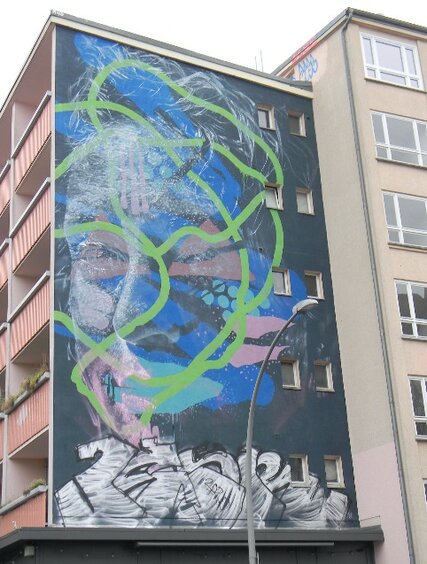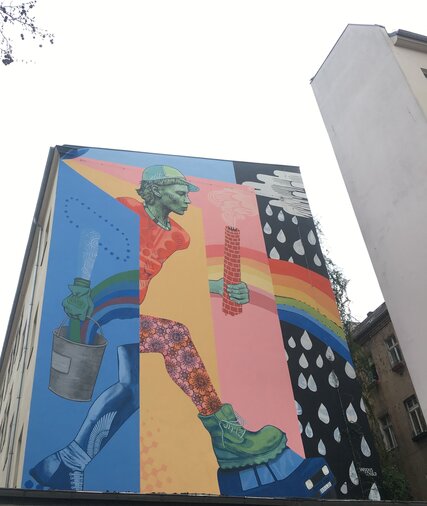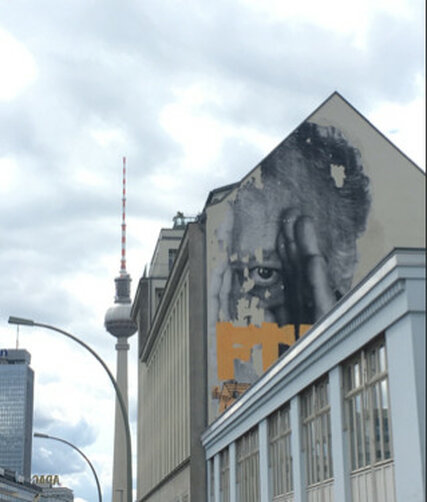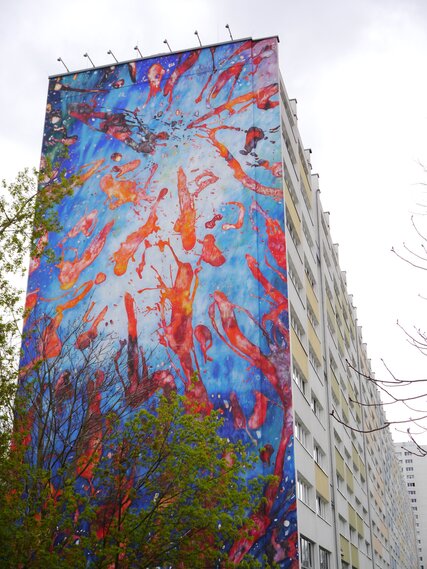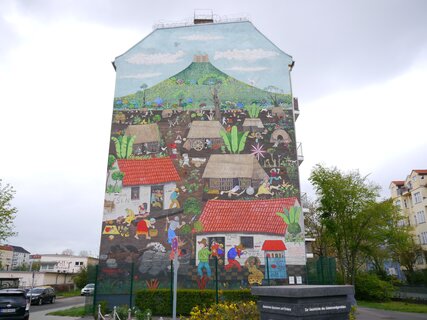Building Murals in Berlin. Art in Architecture in the GDR and Today.
Berlin has a long tradition of artistic engagement with public spaces, buildings, and civil engineering works. As a result, a plethora of sculptures, murals, statues can be found throughout the city. Some objects are hidden; others are placed prominently on walls, in parks, or on streets. Public artworks allow people to encounter art outside museums and function as open invitations to explore their meaning and revel in their wonders. Pankow and Lichtenberg off er public art tours by foot or bike. Participants learn about the creation of the works and their materials along with the social background, life, and output of the artists themselves.
BIKE TOUR Building Murals in Berlin
Stone-age cave paintings, antique mosaics, Michelangelo’s frescos, Mexican murales, gra ti murals in Berlin – wall painting is a tradition both ancient and modern. This tour is dedicated to the large-scale works of art that shape the Berlin cityscape. It provides insights into the biographies of artists, the origins of their work, and the larger historical context. The nearly 30-km tour starts in Pankow, extends through Prenzlauer Berg, Mitte, and Friedrichshain, and ends at Monimbó-Platz in Lichtenberg. For years, Berlin’s firewalls and building facades have served as surfaces for political propaganda, advertising, and neighborhood-defining artworks. Beginning in 1950, a share of statefunded new building constructions in Germany was reserved for „art in architecture“. In the GDR, artists created works for administrative buildings, cultural landmarks, and social housing. Among them was an array of expressive murals. Though some were destroyed, many have stood the test of time and new ones continue to appear. All have one thing in common: they are meant to be seen by everyone.
Station 1: Pankower Marktleben (Pankow Market Life), Artist: Dieter Gantz (1932–2018)
Location: Berliner Straße 1, 13187 Berlin, "Pankower Marktleben" (Pankow Market Life), Artist: Dieter Gantz (1932–2018), Date: 1987
Pankow Market Life has adorned the side of the building at Berliner Straße 1 for over 30 years. The large mural was created in 1987 by Dieter Gantz on the occasion of Berlin’s 750th unniversary. The colorful shapes and gures – many of them have faded with time – give a sense of dynamic movement. Concentric circles revolve around a market populated with people, animals, musicians, and acrobats. The scene depicts Pankow’s Breite Straße market, which to this day remains the oldest weekly market in Berlin. Local residents have been shopping at the market on the old village green since 1857. The large clump of bananas at the foot of the market stall suggests plenitude in a period when shortages of goods – tropical fruits in particular–were common.
Dieter Gantz studied painting from 1951 to 1957 at the Berlin-Weißensee School of Art and earned a degree from the University of the Arts. He subsequently worked as a freelance artist in Berlin and served as the deputy chairman of the local chapter of the Association of Visual Artists of the GDR (VBK). In the early 1980s, he began teaching at the Weißensee School of Art. His studies took him to Russia, Holland and Italy. In 1985 he was awarded the GDR Art Prize. Four years later the artist penned an open letter criticizing the leadership of East Germany.
Station 2: Reliefs at the Berlin-Weißensee Art School, Artist: Jürgen von Woyski (1929–2000)
Location: Bühringstraße 20, 13086 Berlin, "Reliefs at the Berlin-Weißensee Art School", Artist: Jürgen von Woyski (1929–2000), Date: 1955
The wall frieze by the sculptor Jürgen von Woyski frames the main entrance of the Berlin-Weißensee School of Art. Each side is divided into six ceramic panels containing vignettes from life at the art school. The le side’s uppermost panels show scenes from sculpture classes. Below them are students attending a lecture and a drawing course. The reliefs at the bootom show additional scenes from student life. On the right side, the top panels portray a nude drawing and a painting workshop. In the middle are scenes from ceramic workshops. The bottom panels depict the study of architecture in theory and practice. The reliefs were created as part of Woyski’s final exam , which he completed in 1955 a er studying with Fritz Koelle and Heinrich Drake. From 1981 to 1986 he headed the building ceramics department at the school.
The Berlin-Weißensee School of Art in the GDR focused on the applied arts: architecture, commercial graphics, industrial design, ceramics, fashion design, textile and surface design, painting, sculpture, stage design and costume design. Founded a er the Second World War under the name „Art School of the North“ by artists and designers close to the Bauhaus, it was intended to represent an alternative to the traditional academy. In 1947 the school was o cially accredited by the Soviet military administration in Germany.
Station 3: Natur- und Tierbilder (Pictures of nature and animals), Artist: Antje Fretwurst-Colberg (*1940), Friedrich-Wilhem Fretwurst (*1936)
Location: Falkenberger Straße 30, 13088 Berlin, playground behind the building, "Natur- und Tierbilder" (Pictures of nature and animals), Artist: Antje Fretwurst-Colberg (*1940), Friedrich-Wilhem Fretwurst (*1936), Date: 1978
In 1978, Antje Fretwurst-Colberg and Friedrich-Wilhelm Fretwurst were commissioned to design a playground based on the world of children. The playground they created is bordered by seven concrete blocks decorated with colorfully glazed ceramic images showing various scenes from nature and everyday life. The spirited depictions provide stimulating environment for children at play. The motifs are varied and original: from an underwater world to wild animals in the jungle, from parrots and fluttering butterflies to soaring paper kites. The artist couple designed the compositions using paper collages. They then selected the colors and glazed the ceramic before baking in them in a kiln. Some motifs are oversized; others are disproportionately small. The representations are intended to spark childrens’ imaginations and encourage them to come up with their own stories.
The artists met while studying art education at the University of Greifswald. A er teaching in Greifswald and Berlin, both studied painting and graphics at the Berlin-Weißensee School of Art. Until shortly a er reuni cation, both were members of the Association of Visual Artists of the GDR (VBK) and worked as freelancers.
Station 4: Wenn ich wüsste, dass morgen die Welt untergeht, würde ich einen Apfelbaum pflanzen (If I knew That Tomorrow the World Would End, I Would Plant an Apple Tree), Artist: Herakut
Location: Greifswalder Straße 87–88, 10409 Berlin (Heinrich Böll Library), "Wenn ich wüsste, dass morgen die Welt untergeht, würde ich einen Apfelbaum pflanzen" (If I knew That Tomorrow the World Would End, I Would Plant an Apple Tree), Artist: Herakut, Date: 2015
The work depicts a small child sitting on a young woman’s lap. The woman has placed her hand on the child’s head and both look at each other. Another child, behind the woman, strokes her long hair while looking down at the other child. The stringy hair of the children morph into tree-like growths on whose branches small owers blossom. The painting suggests that the children are the blossoms, the apple trees of our future. The title of the mural is a quote from Martin Luther. Translations of the quote appear on the wall in many languages – an expression of Berlin’s diversity meant to convey a sense of belonging.
The graffiti artist duo has worked under the pseudonym Herakut since 2004. Jasmin Siddiqui, alias Hera, is responsible for the execution. The conception, drawings and text work are from Falk Lehmann, alias Akut. Herakut describes their art as „public relations“, a form of communication that can strongly impact society. The mural was created as part of One Wall, a project by the Urban Nation Museum for Contemporary Art in Berlin Schöneberg. Under the motto „One Wall, One Message“.
Station 5: fragen! (questions!), Artist: Karla Sachse (*1950)
Location: Prenzlauer Allee 70, 10405 Berlin, "fragen!" (questions!), Artist: Karla Sachse (*1950), Date: 2005
The art installation questions! is located in a complex of buildings that today make up the administrative o ces for the district of Prenzlauer Berg. Black acrylic glass ribbons with white writing snake around the outside of the structure. Over an area of 320 square meters, the text poses 61 questions. The questions are meant to recall the earlier use of the building. A er the fall of the Wall, in 1990, it emerged that there was a detention center in the basement of building 3. Its 40 cells were run by the Soviet secret service NKVD until around 1950 and were subsequently under the control of the Ministry for State Security (Stasi) until 1956. Many former Nazis and war criminals were held there in inhumane conditions. It was also used as a prison for opponents of the Soviet occupying power immediately following the war and critics of the Socialist Unity Party of Germany (SED) during the East German era.
Sachse formulated the questions a er reading the les documenting the prisoner interrogations. The questions recall the past atrocities that occurred here, and the victims of physical and psychological violence. But they also address issues of violence more generally. Some are meant to be provocative; others, to encourage re ection.
Karla Sachse lives and works in Prenzlauer Berg. At the end of the 1960s she came to Berlin to study art education at the Humboldt University. A er completing her doctorate, she worked as a teacher and an artistic assistant at the Studio Bildende Kunst in Lichtenberg. Since the late 1980s she has focused her attention on visual poetry. Her works include room installations and public art.
Station 6: Suia, Artist: Askew One
Location: Stargarder Str. 82, 10437 Berlin, Suia, Artist: Askew One, Date: 2016
As part of the Urban Nation One Wall project, the New Zealand street artist Askew One designed a mural for a residential building in Prenzlauer Berg in 2016. The face of a young woman emerges from a dark background. The woman is Suia, a Samoan living in Germany and a friend of the artist. With her, One establishes a connection between Germany and his homeland. The three-quarter portrait, which resembles a ne chalk drawing, seems to dissolve on its right edge. The areas of the face in shadow are rendered with opaque and transparent color accents in blue, turquoise and pink – reminiscent of indigenous face painting and modern Pop Art prints. The friendly eyes are overlaid with transparent red triangles. A bright green band courses over the entire portrait.
Askew One is best known for his gra ti work. He is the driving force behind the street art scene in his hometown of Auckland and part of the well-known MSK crew. The gra ti artist’s unique style – he call it „Portraits with alternatives possibilities“ – combines the gurative and the abstract.
Station 7: Dedicated to, Artist: Various & Gould
Standort: Oderberger Str. 57, 10435 Berlin, Dedicated to (2017), Künstler: Various & Gould
A young woman with a fragmented body steps out of a large book. With one leg still on the blue book cover and the other already in the first chapter or the next, she strides across the colorful pages. She has a modern haircut and wears a baseball cap. Her head seems printed; its greenish surface recalls that of a banknote. In one hand she holds a bucket for cleaning or painting; in the other, a demolished, smoking chimney. Her gaze is directed downward, toward a rainbow, which extends from the book’s chapters and indicates the direction of her movement. The mural’s book tells of physical work, artistic creation, industrial production, and technical progress. On the right edge a rain cloud releases thick drops over a dark background. The woman has yet to reach the end of the rainbow.
Dedicated to is part of the series Rabotniki (the Russian word for „workers“), in which Various & Gould examine the social signi cance of work, changes in work and personal experiences.
The Berlin-based artists Various & Gould have worked as a duo since 2005. Both graduated from the Berlin-Weißensee School of Art in 2010. They address crucial social issues such as work, migration, gender, death, globalization, and religion. Their work is in uenced by graphic design, Dada and Pop Art.
Station 8: The Wrinkles of the City, Mr. ZYIA, Artist: JR (*1983)
Location: Torstraße 1, 10119 Berlin, "The Wrinkles of the City", Mr. ZYIA, Artist: JR (*1983), Date: 2013
Mr. ZYIA is a work by the French photographer and street artist JR (* 1983). He is internationally known for his massive photographic portraits. Mr. ZYIA is part of the artist’s international series The Wrinkles of the City and is one of over 15 murals he completed in
Berlin. It shows the face of an older man with bushy eyebrows and dark circles under his eyes. His hands are raised and he is looking intently at something. The seriousness of his gaze is unsettling.
The Wrinkles of the City portrays older citizens: people who have experienced their city’s history and its many changes, people whose experiences are written in their faces. The high-resolution black-and-white photographs are austere and expressive. They create intimacy with the digni ed subjects they portray. For his works in Berlin, the artist selected historical buildings that shape the city and, like the murals on their walls, bear witness to the city’s transformation.
JR has completed projects for The Wrinkles of the City series in many places around the world. More and more, old people have become invisible. JR’s distinctive portraits makes them visible again and gives them a kind of public recognition that underlines their social importance.
JR’s projects are participative: they involve others in the creative process. His anonymity allows him to choose topics freely, while actors, performers or passers-by help shape and mold his work. In 2008 he worked in Berlin with the Italian gra ti artist Blu on the famous Cuvry Graffiti in Kreuzberg, which was painted over in 2014.
Station 9: Unser Leben (Our Life), Artist: Walter Womacka (1925–2010)
Location: Haus des Lehrers, Alexanderstraße 9, 10178 Berlin, "Unser Leben" (Our Life), Artist: Walter Womacka (1925–2010), Date: 1964
The mosaic frieze Our Life by Walter Womacka is located on the Haus des Lehrers („Teacher‘s House“) next to Alexanderplatz. With a height of 7 m and a total length of 127 m, the mural is one of the largest works of art in Europe. The frieze, which wraps around the entire building and extends over two oors, is made up of over 800,000 colorful mosaic stones and various metal plates. The colorful representations, outlined in black, provide shining examples from the life of East German citizens.
The frieze is divided into four areas. On the north side are futuristic representations from science and technology. The east side stands for diversity and friendship between peoples. The south wall shows di erent professions working together. The west side contains everyday scenes from family life, education, upbringing, industry, and agriculture. The couple in the center points both to a peace dove and to the symbol for nuclear energy.
The Haus des Lehrers was completed between 1961 and 1964 based on a design by the architect Hermann Henselmann and was the rst high-rise building at Alexanderplatz. The frieze was chosen in a competition for the East German Ministry of Culture’s „Art in Architecture“ program. The purpose of the competition was to nd an appropriate artwork with an appropriate political message for such a prominent location in the capital. Womacka’s initial design was rejected a er the jury deemed its ideology insu ciently Marxist. The mural we see today was the result of a subsequent collaboration.
Walter Womacka is considered one of the most in uential artists in the GDR. His works mainly include art for buildings and public spaces and monumental wall paintings. Womacka also designed the Friendship of Nations Fountain (1969/70) on Alexanderplatz.
After his apprenticeship as a decorative painter, he studied architecture and fine arts in Weimar and Dresden. Starting in 1953, Womacka taught at the Berlin-Weißensee School of Art; he was rector of the university from 1968–1988. While his work in the time of the GDR was clearly marked by socialist realism, Womacka went in a different direction a er 1990. His later work – mostly graphic art – shows a great admiration for Pablo Picasso.
During the formalism debates of the early 1950s, Western representatives of modernist, subjectivist, and abstract art faced o cial criticism in the GDR. Their formalistic art was anti-democratic, decadent, and bourgeois. In its „ ght against formalism“, the GDR promoted art that was realistic, popular, and political. As a member of the SED, Womacka received signi cant support from the head of state and party leader Walter Ulbricht. From 1959 to 1988 Womacka was vice-president of the Association of Visual Artists of the GDR (VBK). Walter Womacka once said, „All art is political – even the banal."
Station 10: Die Sonne wird im Ozean versinken (The Sun Will Sink into the Ocean), Artist: Ricky Lee Gordon (*1984)
Location: Landsberger Allee 121, 10407 Berlin, Die Sonne wird im Ozean versinken (The Sun Will Sink into the Ocean), Artist: Ricky Lee Gordon (*1984), Date: 2017
The South African artist Ricky Lee Gordon created The Sun Will Sink into the Ocean as part of the One Wall project. Covering the side of the building at Landsberger Allee 121, the mural is vexing. A gray horse, up to its belly in glittering water, stands before a window in a flooded interior. With pricked ears, it looks calmly in the direction of the viewer. Several white doves flutter through the window into the light-filled room. The antique interior and high-contrast style suggest an old black and white photograph. But as viewers near the mural, the contours dissolve and become blurred. The photorealistic representation is o set by its surreal content and dream-like imagery. Gordon breaks with space and time as he forces us to ask: What is real and what is not? The caption „The sun will sink into the ocean“ appears at the bottom edge of the mural. Faded below it are the words „The moon and the water will rise. The kings in their castles are washed away.“ The mural stands for hope, nature’s resistance to destruction, and humanity’s powerlessness against nature.
The South African artist Ricky Lee Gordon is internationally known for his murals. An autodidact, he has devoted himself exclusively to painting since 2014. His formal study began in 2016, when he moved to Los Angeles. His work negotiates pressing social issues and the interplay of humankind and nature.
Station 11: Lebens(t)räume Lichtenberg (Life Spaces / Life Dreams), Artist: Christian Awe (*1978)
Location: Frankfurter Allee 192, 10365 Berlin, "Lebens(t)räume Lichtenberg" (Life Spaces / Life Dreams), Artist: Christian Awe (*1978), Date: 2012
Approaching Berlin from the Lichtenberg bridge, just as the city and its signature television tower come into view, one notices an unusually eye-catching building mural amid a throng of gray concrete structures. Life Spaces/Life Dreams Lichtenberg, by the street artist Christian Awe, was chosen by a team of experts. The work is part of the Lichtenberg Open ART project, an initiative for art and education by the HOWOGE housing association.
The mural consists of vivid red splashes that pour down over a bright blue background resembling the sky. The color accents suggest lava or blood and symbolize Berlin’s pulsating life. The blue background stands for freedom and creativity. (The mural is near the former headquarters of East Germany’s Ministry for State Security (Stasi) and situated on what was once the „Street of Liberation“.) Awe’s work leaves much room for free association and interpretation. Viewed up close, many small details emerge. During the day, the sky-blue background seems to merge with the surroundings. In the dark, halogen spotlights illuminate the facade, putting the rhythmic color composition in a new light. The project took almost three months to complete.
Station 12: Nicaraguan Village – Monimbó, Artist: Manuel Garcia Moia (*1936)
Location: Skandinavische Str. 26, 10317 Berlin, Nicaraguan Village – Monimbó, Artist: Manuel Garcia Moia (*1936), Date: 1987
This colorful mural is the work of the Latin American artist Manuel Garcia Moia. The representation shows scenes from daily life in Monimbó, a rural district in the city of Masaya, which lies at the foot of the Masaya volcano in southwest Nicaragua. At rst glance, the mural seems to portray an idyllic village. But chaos has broken out in Monimbó: armed soldiers invade the village, while masked and hooded residents, armed with ri es, machetes and stones, try to fend them o . Injuries and deaths result on both sides.
The mural o ers a snapshot of what happened in 1978 in Moia’s hometown. On February 20, 1978, the local population in the isolated district of Monimbó rose up against the Somoza regime. The unrest was was violently suppressed, with Somoza‘s mercenaries killing 343 local residents. The events in Monimbó were just one of many protests and uprisings against the Somoza dictatorship to occur in 1978 and 1979. The political slogans on the facades of the whitewashed houses in the foreground are directly related to historical events. „SANDINO VIVE VIVE“, „VIVA FSLN“, and „GPP“ refer respectively to Augusto César Sandino, the head of the Nicaraguan resistance against the US occupation during the 1927 civil war; the guerrilla organization „Frente Sandinista de Liberación Nacional“.
The Nicaraguan Revolution (1979–1990) was supported by the GDR government. In 1985, the East German Ministry of Culture and the East Berlin City Council commissioned Moia to paint a mural commemorating the Nicaraguan people’s struggle for freedom and the atrocities of the Somoza regime. With the help of Martin Ho man and Trakia Wendisch, Moia created a monumental work of naïve painting. Moia’s mural on the building at Skandinavische Straße has undergone a number of
changes. In 2003, the original work disappeared behind a layer of insulation a er the building was renovated. Thanks to a citizens’ initiative, the mural was reconstructed in 2004–2005 by Gerd Wul and Max Michael Holst and personally signed by Moia. After the plaster began to crumble due to faulty construction, the entire wall had to be redone. Later, Halim Bensaid, Steve Rolle and other artists repainted 255 square meters of the wall with a view of Monimbó from 2019.
Manuel Garcia Moia grew up in a poor family but because of his talent was able to study with the well-known Nicaraguan painter Rodrigo Peñalba. Moia gained international attention as a representative of naive painting. A er receiving Nicaragua’s national prize for painting, he created murals around the world. Unfortunately, only Nicaraguan Village – Monimbó 1978 and several other painting in Managua have survived.
